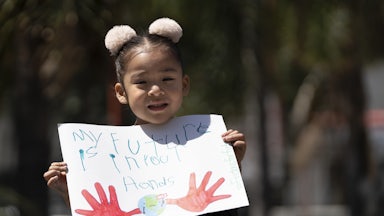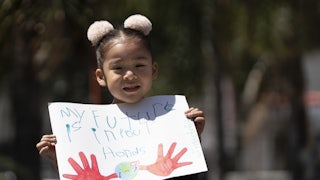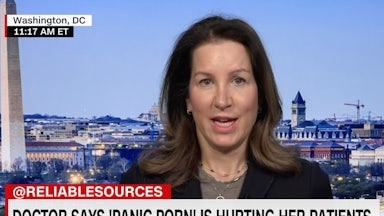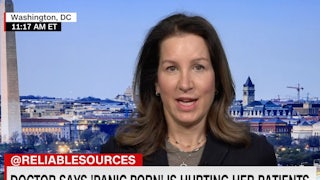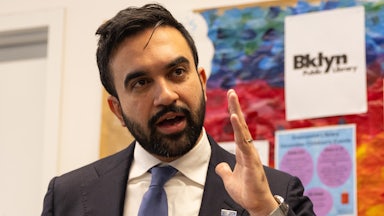Daphne Steel has, in some ways, had a normal childhood. She swam and cheer-led, she trampolined to Miley and danced to Taylor, she watched Finding Nemo over and over. But due to malformations that disrupted her development and ignited seizure after seizure, she also spent countless hours at Tufts Children’s Hospital.
Despite Daphne’s health challenges, her mother, Kelly, had the utmost confidence in her daughter’s medical team. Daphne’s neurologist was “the best in the world,” and the pediatric unit “was like our home base,” she said. Then, in January 2022, she got a letter saying Tufts Children’s Hospital was closing. “At first I thought I was reading it wrong,” Kelly said.
At the end of March, Daphne started projectile vomiting. Then came seizures longer and worse than she’d ever had. Kelly rushed her to the nearest emergency room. They didn’t know what was going on and needed to transfer her. But Tufts—which, technically, wasn’t supposed to close until July—“wasn’t taking anyone,” and Boston Children’s—which, technically, was accepting all displaced Tufts patients—“was full,” she recalls being told. So they were emergently evacuated to a third hospital in Worcester, Massachusetts. It took hours to get Daphne the C.T. scan that finally explained what was going on: Her 8-year-old was having a stroke.
When a children’s hospital closes, children with chronic diseases don’t just lose a home base they know and love: They lose a place that knows them—a loss which, in emergencies, can be deadly. Of course, children without chronic diseases suffer too: When they get bronchiolitis or appendicitis or hemolytic uremic syndrome, there’s one place less to go.
The closure of Tufts Children’s is part of a broader trend of hospitals shutting down their pediatric units. In recent years, one out of every five pediatric hospital units has closed.
But the pandemic intensified these trends. As adults reeled from severe Covid-19 infections, children were largely spared. All told, hundreds of thousands of children who would have been hospitalized in a typical year weren’t, during the height of the pandemic. Hospitals lost hundreds of millions of dollars from the empty beds. Adults have long been more profitable for hospitals than children; amid the gutting pandemic-era losses, some, like Tufts, took the opportunity to make the decision: They were getting out of the kid business.
Now, amid the so-called “tripledemic” of Covid, influenza, and RSV, children across the country have struggled to get the care they need. Hospitals that do still treat kids are buckling, unable to accommodate them but simultaneously with nowhere to send them. Emergency rooms are overloaded; stretchers with children needing oxygen tanks to breathe line the hallways.
Did it have to be this way?
Lisa Capra has worked as a pediatrician in the Boston area for almost three decades. After completing her residency at Tufts, she stayed on as a hospital pediatrician and helped open Tufts-staffed pediatric units at hospitals from Brockton to Barnstable.
“I heard throughout my career that ‘pediatrics loses money,’” Capra said. “There was always the concern about the viability of the pediatrics.”
But for a long while, those concerns were mostly theoretical—or relevant to other hospitals but not hers. Then, in 2020, MetroWest Framingham closed its pediatric ward—a ward she’d help start. That stung, but didn’t totally surprise, Capra said. The unit had been treating fewer and fewer kids over the years.
Two years later came the big surprise, when Tufts Children’s announced it was boarding up. “The market’s changing, the demands are changing, the community needs are changing,” Michael Tarnoff, chief executive of Tufts Medical Center, told The Boston Globe at the time.
But multiple doctors and nurses from Tufts Children’s told me that around the time of the announcement, the hospital was packed. “We were doing better than ever before,” Capra said. Closing the hospital “seemed impossible—it was unbelievable.”
Contacted for comment about these discrepancies, a Tufts Medical Center representative called the children’s hospital closure “an extremely difficult decision,” reiterating that it was driven by “rapidly evolving patient care needs.”
Documents filed by Tufts with the Massachusetts Health Policy Commission suggest the decision may have had more to do with finances. Citing high salaries, delayed elective surgeries, sicker patients, and inflation costs, Tufts leadership wrote that 2022 “had a serious negative impact on our financial performance.”
Tufts is not alone. As Capra was taught, pediatric hospitals across the country have long struggled to make the big bucks. Data from the Department of Health and Human Services suggests hospitals make some $20,000 more per admission from adults compared with children.
Over the same period, hospitals have shed their pediatric units. A recent study found that the number of pediatric units decreased by 19 percent and the number of pediatric beds dropped by 12 percent between 2008 and 2018. The drops have not affected all communities equally: For example, in Illinois, 27 percent of beds disappeared in recent years—despite the overall need for hospitalizations actually increasing during this period.
Covid may have supercharged these trends. One out of every six pediatric beds that would have been filled and generating revenue in a typical year was empty, according to HHS data. A 2021 study found that the vacancies led to hundreds of millions of dollars in lost revenue across 26 children’s hospitals. Data obtained by The New Republic from the Iowa Department of Health and Human Services—one of the few states with recent data on pediatric hospital beds—showed that the rate of bed closures in the state between 2019 and 2021 was double the national average over the preceding decade. Now that children’s illnesses are surging again, that’s caused a crisis.
When pediatrician Lindsay Fox has gotten called down to the emergency room at MetroWest in recent weeks, the scene has been bleak. Waiting rooms overflowing with kids doubled over in coughing spells. Hallways overflowing with kids receiving vaporized medicine from nebulizers. Rooms overflowing with kids getting oxygen pumped into their lungs to breathe normally.
Fox does what she can to help lighten the load: She helps triage, she eyeballs the most complicated children, she provides advice. But ever since MetroWest shuttered its pediatric beds, her hands are tied.
“I get a lot of questions, like, ‘Can’t you guys just care for these patients?’—and I have to say, ‘Well, we don’t have beds, and we’re not licensed to provide this care,’” she said. “We’d love to, but we can’t.”
Another obstacle has been an exodus of pediatric expertise. When the unit at Framingham closed, Fox said, many nurses and doctors also left. The experience at Tufts was similar, said Mary Havlicek Cornacchia, chair of the Massachusetts Nurses Association’s bargaining committee at the hospital.
“It felt like an ongoing wake for six months,” Havlicek Cornacchia said. “Every day, you’re coming in, thinking this is all coming to an end.” Amid that uncertainty, staff scrambled to find new opportunities.
The consequences of the lost beds and the lost staff can be dramatic. Caring for children requires special training and isn’t one-size-fits-all, MetroWest Emergency Department nurse Ed Burman said: A 3-month-old is a totally different animal than a 3-year-old. Knowing whether a kid breathing 40 times a minute is normal or a sign of impending collapse, he added, takes specialized knowledge and hard-earned experience.
While federal laws require that all emergency rooms care for children, the extent of care they provide can differ. For example, some can provide advanced breathing support through machines like CPAPs and ventilators, while others can’t. Children who go to emergency rooms at hospitals that do not routinely provide care for children are up to four times more likely to die. “Everybody thinks a bed is a bed is a bed and a hospital is a hospital is a hospital,” Michael McManus, a pediatric anesthesiologist at Boston Children’s Hospital, said, “until you get sick.”
During the tripledemic, things have only been strained further. “We are just packed—I’ve never seen it like this my entire career,” said Burman, who has been a nurse for 30 years. Hospitalization rates from Covid surging to the highest they’ve been since the advent of the omicron variant is only straining the system further. (The majority of children are cared for at hospitals that also treat adults.)
Collectively, these forces—lost beds, lost staff, swarmed emergency rooms—mean that kids with acute conditions are often waiting longer and longer for care across the country. In Framingham, children who once could be in and out in minutes now may have to wait hours for care, Burman said.
During that waiting period, their condition can deteriorate abruptly. “As adults, we compensate, we compensate, we compensate, we reach a breaking point, and then we decompensate, decompensate, decompensate,” Burman said. “With kids, they compensate, and then they crash.” And with staff already stretched thin, monitoring how every patient is doing all the time is a tall order. As volumes increase, the chances that patients can be reassessed while they wait decreases by up to 30 percent.
There’s also the situation where children need prolonged care—but they’re at a hospital like MetroWest or Tufts or the hundreds of other centers that no longer hospitalize children. In those cases, they need to be transferred to somewhere that does. But arranging those transfers amid the diminishing supply and skyrocketing demand for beds is harder than ever—especially in parts of the country where the nearest children’s hospital may be hours away.
In Framingham, before the closure, “99 percent of our transfers would go to Tufts,” Burman said. “Now, you call and there’s no bed available—so you say, OK, I’m going to try this hospital, I’m going to try that hospital, I’m going to try the other hospital.”
Children who are accepted elsewhere may have to wait hours more: Ambulance companies, also facing surging volumes and short staff, are in some cases postponing pickups by hours, Burman said.
Every incremental delay, he added, is simply another opportunity for a child to go from sick-but-stable to critically ill. Patients needing transfers are 60 percent more likely to go on a ventilator and 70 percent more likely to die than those of the same severity who do not.
None of these problems are unique to MetroWest or to Boston. A recent letter from the Children’s Hospital Association, or CHA, and the American Academy of Pediatrics, or AAP, urged the Biden administration to declare a national emergency amid “capacity issues in pediatric hospitals [and] serious workforce shortages [that] are combining to stretch pediatric care … to the breaking point.”
Daniel Hayman religiously tunes in to the Grand Ole Opry every Saturday night. A devotee of Vince Gill and Carrie Underwood, Daniel is a “country music savant,” according to his mother, Joyce Hayman-Devolve.
Harmonicas aside, like many others with cerebral palsy, Daniel’s day-to-day life is complicated. He depends on a wheelchair to get around, on his parents to interpret his speech, and on a tube that injects goopy off-white fluid directly in his belly for sustenance.
But due to the closures, he’s gone months without care. Daniel, who is 37 years old, stuck with his Tufts pediatricians well into adulthood. (Pediatricians often have more experience with the intricacies of cerebral palsy than do adult doctors.) Changing that was never part of the plan: His parents intended on sticking with his Tufts pediatricians even after the closures. “The good news is that other than when a child needs overnight care, the vast majority of services currently available at Tufts will remain open and unchanged,” the hospital’s leadership promised in a February 2022 letter to families.
That hasn’t been their experience at all, Joyce said. Because Daniel is medically stable, he was discharged from his primary care doctor’s clinic a few years back. Since the closure, he hasn’t been able to get into the kind of pediatric treatment—gastroenterology and rehab medicine, neurology and primary care—that he needs. “We worked with every single patient and family impacted by this decision to assist with their care transition,” a representative from Tufts Medical Center wrote when contacted for comment about patients like Daniel struggling after the closure. “Due to patient privacy laws, we cannot comment on any specific patient case.”
“I plan for A through Z; that’s my life,” Joyce said. But now she doesn’t know who to reach out to, or where to go, if things go south. These days, Daniel’s care is “so tremendously piecemeal that it’s scary,” Joyce added.
Many children with chronic conditions are facing a similar dilemma following the Tufts closure. A pre-closure Facebook group titled “Keep Tufts Children’s Hospital Open!” contains story after story: the child who’s facing a two-year wait to get worked up for developmental delay; the child who hasn’t been able to get in to see an orthopedist; the child who now crosses state lines for care because their autoimmune disease—a new diagnosis that still faces controversy in some corners of the medical community—isn’t treated at any other center nearby.
This creates a serious equity problem nationwide. When the millions of children across the country with chronic conditions don’t have a home base for consistent care—a so-called “medical home” model—emergency department visits and hospitalizations double, and the number of serious illnesses and ICU stays triples, one study found. Between 2016 and 2017, Black and Hispanic children with chronic diseases were 20 percent less likely to have medical home bases than those who were white. Since then, dozens more pediatric hospitals have closed.
These closures also carry with them financial costs, beyond the medical ones.
Often, hospitals argue that merging, rolling up, or closing smaller units will reduce overall health spending. “I am convinced, by working together we will expand access to high quality care in a way that also addresses the need to lower the overall cost of health care,” Michael Dandorph, president and CEO of Tufts Medicine, said in the closure announcement.
But whether that’s the case remains unclear. In Massachusetts specifically, prices for pediatric care are 25 percent higher at Boston Children’s Hospital than at Tufts, The Boston Globe found. A report from the Medicare Payment Advisory Commission to Congress stated that the “preponderance of the research suggests that hospital consolidation leads to higher prices”—in some cases, up to 50 percent higher. Amid these concerns, in July 2021, the White House released an executive order directing the Department of Justice and the Federal Trade Commission to crack down on hospital consolidation.
Even the hospitals themselves have doubts: “[We] are not able to assure patients that, for care received at Boston Children’s Hospital, their cost sharing will not exceed their cost sharing for the care if it had been provided at [Tufts] Medical Center,” leadership wrote in documents submitted to the Massachusetts Department of Health four months after the initial announcement.
“Frankly, I am not sold,” said Ruthzee Louijeune, a Harvard-trained antitrust lawyer and city councilor at large in Boston, who called cost “a black box.” Louijeune is concerned about the closure’s impact on patients—including those from historically marginalized communities like the Haitian-American community she grew up in and now serves.
“We have a responsibility to separate the emotional response from what is the right thing—as in, does this makes sense?” she said. “And I don’t mean C-E-N-T-S.”
Daphne eventually received a diagnosis for a condition called PTEN hamartoma syndrome, which affects fewer than 400 of the 74 million kids in America. And while the Pixar-lover eventually recovered from her stroke, Kelly fears what could have happened if things had gone differently. For example, if the bleed had continued oozing, becoming large enough to push part of her brain out of her skull. She also worries about what might happen if Daphne gets another stroke and this time, during the tripledemic, there’s no room for them.
Policymakers could choose to intervene in a variety of ways. McManus has studied hospital mergers and closures—what researchers refer to as “regionalization”—for over two decades. “If things are intentionally regionalized, you could put together a great system,” McManus said. “But if it’s regionalized by default, because the smaller guys go out of business,” he added, pointing to what’s happened in the Boston area, “you get what you get.”
They could also offer federal assistance. To support the care of children like Daphne, in a November letter to Congress, the CHA requested hundreds of millions of stimulus dollars from Congress. And in December, the AAP released a “critical update,” stressing the importance of getting children with long-term diseases the care they need.
“From a societal view … our strength is our children,” Lisa Capra said, “I can’t think of any more important investment.”
That the nation’s children seem instead to be receiving less investment every year, she added, “just reflects society’s values.”



